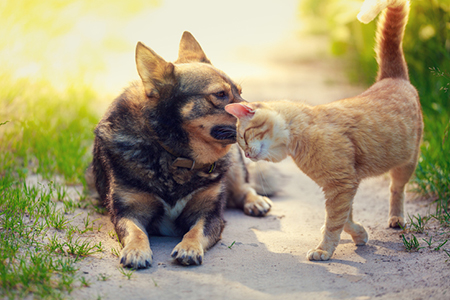(TNS)—Many summer activities we all enjoy can be dangerous for our furry friends, largely due to the intense heat. Here are some things to watch out for to keep our pets safe:
Dangers Outdoors
Heat Stroke or Heat Stress – Leaving your pet outside or in the car for too long can lead to heat stroke or stress. Tara Lynn, communications manager at the SPCA of Wake County, N.C., says the temperature inside a car can get to the point of extreme danger in less than 15 minutes.
Page Wages, a veterinarian at Care First Animal Hospital in North Carolina, says she’s seen two dogs die of heat stroke, both Labrador Retrievers. She said dogs will pant and not be able to stop, which usually they would after eight or so minutes.
“Cats will breathe with their mouth open, which is not good. They just basically can’t cool off. They’ll be unsettled or they’ll pace a lot. Bulldogs and dogs with smushed heads, smaller dogs or the ones that are really, really, really active, like a young Lab, are more prone to having it,” she says. “Their faces around their eyes will get red; their tongues will get red, as well. Their gums will be bright red. Sometimes they’ll vomit or have diarrhea. When those are happening, we are in dire straits.”
Lynn recommends making sure your pets always have access to plenty of cool, fresh water.
Hot Pavement or Hot Sand – Hot pavement or hot sand can burn the pads of your pets’ feet, which is very painful.
“A good general rule is if you put the back of your hand down on the sidewalk or the street and leave it there for about five seconds, if it’s too hot for you, it’s definitely going to be too hot for them,” Lynn says.
Sunburn – “Some pets, particularly dogs that have particularly thin hair or some dogs who don’t have much hair at all on their bellies, they can potentially get sunburned. So talking to your vet about some safe options for sunscreen is important,” Lynn says.
Wages says Neutrogena pediatric sunscreen is safe to use on dogs.
Snake Bites – Snakes come out at dusk and dawn, and have an increased presence at the beginning and end of the summer or after a big rain, Wages says.
“Stay away from high grass areas around where there’s water. Those are usually where those guys will lurk and wait,” she says. “Just generally, the snakes put up a bit of a smell, so dogs and cats will be interested and might go investigate and get bit. If the dog or cat seems to be interested in something in the grass or bush area, try and get them away as quick as you can. If they do get bit, they need to be seen by a veterinarian as soon as they can.”
Bee Stings – Some dogs and cats, just like people, are allergic to bee stings. Their faces will swell up. Wages recommends Benadryl for bee stings, but some pets may need something stronger, like steroids.
Fire Ant Bites – Wages says pets will get a rash or a very swollen area around the bites, which are often concentrated around legs and feet.
Hot Spots – Found on dogs, these are irritated, red lesions, similar to eczema in people. “They usually start with a bug bite they chewed on or an area they got wet from playing with another dog that just stayed moist. Bacteria will grow on any moist skin, and they’ll get infections,” Wages says.
Cookouts or Parties
Burns From Grills – “I think one of the main things is a hot grill, and dogs smelling whatever’s cooking on the grill and getting really close to the grill, and depending on what kind of grill, if they get under it, they run the risk of being burned or hot grease dropping on them and burning them,” Lynn says.
Certain Foods and Plants – Raisins, grapes, garlic, onions and chocolate are toxic to dogs, and lilies are toxic to cats. Lynn points out that raw meat can upset the stomachs of pets that aren’t accustomed to such a diet, so keep a close eye on what they eat.
Alcoholic Beverages – Dogs and cats can get drunk just like people, but they shouldn’t. Do not give beer or liquor (or marijuana, in any form) to your pets.
In the Water
Ear Infections – Ear infections are more common in the summer months, when dogs are swimming more. “Cleaning their ears routinely (with an appropriate ear cleaner) will help prevent them from getting an infection,” Wages says.
Limber Tail – This is when a dog has a sprained tail. It happens when dogs are playing in the surf at the beach and get turned over the wrong way, or if they’ve had a very active day.
“When a dog’s tail is sprained, they’re injured but they don’t know how to act. They’ll sit there and shake sometimes, but they don’t want to stand up because when they stand up, something hurts, but they don’t know what, so they sit down,” Wages says. “It’s really sad. Or, they’ll walk along and it’s just kind of limp behind them instead of wagging.”
With treatment such as pain medication, a muscle relaxer and sometimes laser therapy, dogs are usually better in three or four days.
Drowning – While most dogs know how to swim, it’s a good idea to put a life jacket on your dog, Wages says.
“Labs and breeds that are always in the water are fine, unless they’re going to be swimming for a while, in which case I’d put a life jacket on them. If you’re out on a boat in the ocean, I would put a life jacket on them, because if something happens to the boat and the boat goes over, the dog’s going to get tired of swimming,” she says. “Any older dog or dog that has an injury of some sort—had an amputation or one of their legs doesn’t work as well—I’d put them in a life jacket regardless. I’d highly recommend life jackets.”
©2017 The News & Observer (Raleigh, N.C.)
Distributed by Tribune Content Agency, LLC
For the latest real estate news and trends, bookmark RISMedia.com.











